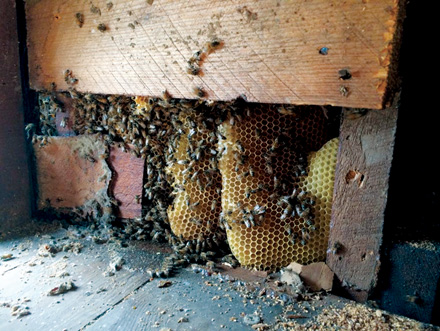Cleaning House

Of all of the bee calls I had this year, this one in Licking was the most intriguing. It was an old house that needed to be demolished. Workers did not want to approach the two-story building until the current residents, a colony of honeybees, had been removed.
When David Draker, Rolla, and I joined Cheryl Hinchman, Dixon, on the site, the first thing we did was follow the bees. Well, we set up our temporary work tables and put on our bee suits first but yes, then we followed the bees. Based on seeing bees gathering outside of the second floor, we tried to guestimate where the bees had established themselves and started to take the outside walls off.
Sure enough, we found solid wax comb full of honey and a lot of worker bees, but no brood, or baby bees. We had found their equivalent of a larder with winter food, the honey, but we still needed to locate the nursery.
Moving downstairs, we found two inches of dead bees on the kitchen floor, where bees had died unable to get outside. Following where the studs met the second floor, we started to cut out the kitchen ceiling sheet rock to see if more wax comb was there. As we removed the sheet rock, we exposed the nursery. Thousands of worker bees were keeping the little baby bee cells warm in wax comb that was so dark brown, it must have been in the home for many years.
Before we could remove the brood in the comb, we needed to get worker bees out of the way. We first used a bee vacuum to gently remove as many of the worker bees as we could. Then we started to cut the wax comb full of brood and attached them to beehive frames with rubber bands so worker bees could finish the job. Once we placed the frames in a beehive box, worker bees would re-attach the wax comb to the frames with more wax within a week or so. They also don’t like the rubber bands but those are harder for them to remove so we do once we see the comb is safely waxed back in.
We also kept our eyes out for the queen but no one was sure we had captured her.
The queen determines the genetics, and disposition, of a colony. She also has a unique pheromone bees follow. With the queen in hand, our job gets a lot easier because the worker bees will follow her anywhere we place her.
It was a very hot, Missouri summer day but with all of the bees agitated, it was not a good idea to take off our bee suits. Cheryl and I did make a stop at the local hardware store in our bee suits to get some light bulbs. The store clerk and a couple of other customers were very polite, not one of them said anything about us having our pants legs tucked into our white socks pulled up to our knees.
It took four people about five hours to remove most of the wax comb and bees. Since we didn’t get the queen, she may still be in the empty house gearing up for developing a new colony, we haven’t been back to check.
As far as the bees we removed, they didn’t make it. There are several theories on why not but we did try. I have a feeling if we went back, we would find more bees once again settling back in. So much for cleaning out the house.
Charlotte Ekker Wiggins is a certified gardener, beekeeper and sometimes cook. Copyright 2016 used with permission, all rights reserved. This material may not be published, broadcast, rewritten or redistributed. Contact Charlotte at chargardens@gmail.com.

WHERE COULD THEY BEE? – We found some bees and comb on the second floor but it was full of honey. Where were all of the bee babies?

MYSTERY SOLVED – The rest of the colony, including baby bees, were established in the ceiling of the kitchen. (Photos by Charlotte Ekker Wiggins).



Facebook Comments